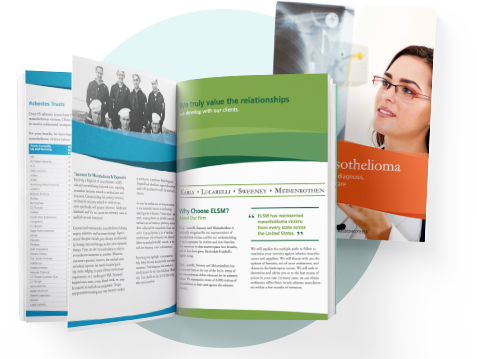What Is Secondary Exposure to Asbestos?
Secondary asbestos exposure happens when a person who is exposed to asbestos in the workplace brings these hazardous fibers home with them. This can put family members at risk for developing mesothelioma and other cancers.
If you’ve been diagnosed with mesothelioma and lived with someone who worked with or was exposed to asbestos, you may be eligible to receive financial compensation.
Understanding Secondary Asbestos Exposure
Most people are exposed to asbestos in the workplace, known as occupational exposure. According to the World Health Organization (WHO), 125 million workers globally are exposed to asbestos on the job each year.4 However, nonoccupational exposure is also relatively common, and may explain approximately 20% of mesothelioma in industrialized countries.3
Nonoccupational asbestos exposure includes environmental exposure and para-occupational exposure:
Environmental Asbestos Exposure
Asbestos is a naturally occurring mineral that forms in deposits in mountainous regions around the world. Environmental exposure typically occurs in communities near these natural asbestos deposits, especially if there is an active asbestos mine. While asbestos is no longer produced in the U.S., there were previously asbestos mines in Alaska, Arizona, California, Montana and Vermont, and the last one didn't close until 2002.
Para-Occupational Asbestos Exposure
Para-occupational exposure, also known as secondary or secondhand asbestos exposure, occurs in the families of workers who have been exposed to asbestos on the job.

Before the dangers of asbestos were known and regulations were put in place, workers would frequently bring home dust that contained asbestos on their clothes, shoes and hair. Potential ways family members could be exposed to asbestos dust include:
- Direct physical contact, like a hug or a child being picked up.
- Handling or laundering clothing with asbestos fibers. The fibers become embedded and do not come out with a typical household washing machine.
- Through household furniture. Sitting on a couch or bed containing asbestos fibers can release them into the air again and again.
- Through the home’s carpet. Asbestos fibers easily become embedded in the carpet, where they can be repeatedly disturbed by things like walking and vacuuming.
- Driving in a contaminated vehicle or using contaminated tools for household repairs.
One example of secondary asbestos exposure is Heather Von St. James. Heather was exposed to asbestos that her father, a drywall worker, brought home on his clothing. Heather would frequently wear her father's work jacket around the house, unknowingly exposing her to the hazardous fibers. She received a mesothelioma diagnosis at just 36 years old, but today, she’s been declared cancer-free. Stories like hers are all too common among the family members of asbestos workers.
Mesothelioma and Secondary Asbestos Exposure
Mesothelioma is a rare cancer that affects the lining of the lungs (pleural mesothelioma) and sometimes the lining of the abdomen (peritoneal mesothelioma). According to the American Lung Association, there are about 3,000 new cases per year in the U.S. and 8 out of 10 people diagnosed with mesothelioma report asbestos exposure.2 Exposure can also result in other asbestos-related diseases, including lung cancer, ovarian cancer and asbestosis.
Occupational, environmental or secondary asbestos exposure can lead to any of these diseases. If you inhale the tiny, sharp fibers, they can embed in your lung tissue. You may also swallow the fibers, which then make their way into the lining of your abdominal cavity. Asbestos fibers cannot be removed from the body. They trigger inflammatory reactions that can lead to scarring and changes in the cells that cause cancer.

A complete guide delivered next day to your doorstep. Treatment Information, top doctors & cancer centers, financial assistance and more.
Who’s Affected by Secondary Asbestos Exposure?
No amount of asbestos is safe to inhale. Both heavy, short-term exposure and exposure to lower concentrations over a long period of time pose a risk. The risks of secondhand asbestos exposure are therefore greatest for family members of workers most at risk of being exposed to asbestos on the job.
Family Members of High-Risk Workers
Even though asbestos use is less common today, it was widely used in many industries from the 1920s through the early 1980s. Because diseases like mesothelioma can take decades to develop, many family members who were exposed before asbestos use declined and regulations were put in place are just now being diagnosed.
Certain occupations also continue to be exposed to asbestos in high concentrations. While the Occupational Safety in Health Administration (OSHA) has put guidelines in place to help prevent secondary asbestos exposure, it can still occur if they’re not carefully followed.
Studies show that family members of these workers may face an increased risk of developing mesothelioma.3 These at-risk occupations include:
- Asbestos removal workers
- Auto mechanics
- Carpenters
- Construction workers
- Electricians
- Firefighters
- Industrial workers
- Insulators
- Maintenance workers
- Military service members
- Miners
- Paper mill workers
- Pipefitters
- Plumbers
- Railroad workers
- Roofers
- Shipyard workers
- Teachers
- Welders
Women Exposed to Asbestos at Home
Research shows that women are most affected by secondary exposure to asbestos.
One study found that women exposed to asbestos in the household have 10 times higher mesothelioma risk than those who were not exposed.7 Another found that more than half of women with mesothelioma were exposed in the household.5 This is most likely because men have traditionally held many of the jobs that result in occupational exposure, while women have performed the household tasks that could result in secondary exposure.
The wives and daughters of workers exposed to asbestos may be at the highest risk. In one study that included 33 women with household-exposure mesothelioma diagnoses, 22 of them were wives and 9 were daughters.1 Another study of 32 cases found 15 were in wives and 11 in daughters.6
While studies have found most cases in wives and daughters, cases were also observed in sons, mothers, in-laws, nieces and roommates. Anyone living with a worker exposed to asbestos could be exposed themselves, especially before the early 1980s.

Legal Options for Victims of Secondary Exposure to Asbestos
A mesothelioma diagnosis is life-altering. It's important to take care of yourself or your loved one and spend plenty of time with those you care about. It's also important to know about your options for mesothelioma compensation.
Asbestos Trust Funds
It wasn't until consumers began filing mesothelioma claims in the 1970s and 1980s that the dangers of asbestos became more well-known. Many companies declared bankruptcy due to these lawsuits. As a part of their settlement agreements, they created asbestos trust funds to pay compensation to their victims, including victims of secondary exposure to asbestos. An experienced lawyer can help you file a claim with an asbestos trust.
Mesothelioma Lawsuits
Today, mesothelioma lawsuits brought by victims of secondary asbestos exposure continue. Filing a lawsuit against the company responsible for your exposure can help you receive the maximum compensation, as long as you file within the statute of limitations. Settlements and verdicts average over $1 million and can run much higher.
At Early, Lucarelli, Sweeney and Meisenkothen, we’ve won millions in compensation for victims of secondary asbestos exposure, including $5 million in California, $3.6 million in Connecticut and $2.7 million in Missouri. We’re ready to put that experience to work for you.
Contact us for a free case evaluation and let’s get started.
FAQs
Who is at risk of secondary asbestos exposure?
The family members of workers in high-risk occupations are most at risk of secondary asbestos exposure. These occupations include asbestos removal workers, auto mechanics, construction workers, firefighters, maintenance workers, military veterans, plumbers, roofers and welders. Studies also show that wives and daughters are at the highest risk, most likely because they perform household work that could put them in contact with hazardous asbestos fibers.
How does secondary asbestos exposure happen?
Secondary asbestos exposure occurs when a worker who has been exposed on the job brings home asbestos-containing dust on their clothes, shoes and hair. From there, it can transfer onto other members of the household, or get in the furniture and carpets, exposing anyone in the home. Asbestos fibers could also be in their vehicle or on tools they bring home from work.
What are the health risks of secondary asbestos exposure?
Secondary asbestos exposure can lead to the same serious illnesses as occupational exposure. These include mesothelioma, lung cancer, ovarian cancer and asbestosis. Because it can take decades for these illnesses to develop, many people aren't even aware that they've been exposed to asbestos.
Are there lawsuits related to secondary asbestos exposure?
Yes, victims of secondary asbestos exposure are entitled to compensation, just like those exposed on the job. A lawyer can help you determine how you were exposed so you can file a personal injury lawsuit against the appropriate parties. It's important to find an experienced mesothelioma law firm with the resources to help you prove your case.
Request a Free Case Evaluation
Request a free case evaluation now if you or someone you love has been diagnosed with mesothelioma. The evaluation will cost you nothing. Our lawyers will travel to visit you at your convenience or conference call with you over the phone. We understand how difficult a time this is for you and will assist in any way that we can. You can also call us toll-free at 1-800-336-0086 at any time.
Sources
- Agostin, F, Michieli, P, et al. Int J Occup Med Environ Health. May 2017, 30(3):419-431 doi: 10.13075/ijomeh.1896.00890.
- American Lung Association,Learn About Mesothelioma, last updated August 7, 2023.
- Goldberg, M and Luce, D. Eur J Cancer Prev. Nov 2009, 18(6):489-503. doi:10.1097/CEJ.0b013e32832f9bee.
- IARC Working Group on the Evaluation of Carcinogenic Risks to Humans. Arsenic, Metals, Fibres and Dusts, Volume 100C. 2012.
- Langhoff, M, Kragh-Thomsen, M, et al. Dan Med J. Sep 2014, 61(9):A4902. PMID: 25186542.
- Miller, A. Am J Ind Med. May 2005, 47(5):458-62. doi:10.1002/ajim.20167.
- Vianna, N and Polan, A. The Lancet. May 1978, 311(8073):1061-63. doi:10.1016/S0140-6736(78)90911-X.




